2003 INFINITI G35 tire pressure
[x] Cancel search: tire pressurePage 151 of 256

During the first 1,200 miles (2,000 km), follow
these recommendations to obtain maximum
engine performance and ensure the future
reliability and economy of your new vehicle.
Failure to follow these recommendations may
result in shortened engine life and reduced
engine performance.
O Avoid driving for long periods at constant
speed, either fast or slow. Do not run the
engine over 4,000 rpm.
O Do not accelerate at full throttle in any gear.
O Avoid quick starts.
O Avoid hard braking as much as possible.
O Do not tow a trailer for the first 500 miles
(800 km). O Accelerate slowly and smoothly. Maintain
cruising speeds with a constant accelerator
position.
O Drive at moderate speeds on the highway.
Driving at high speed will lower fuel
economy.
O Avoid unnecessary stopping and braking.
Maintain a safe distance behind other ve-
hicles.
O Use a proper gear range which suits road
conditions. On level roads, shift into high
gear as soon as possible.
O Avoid unnecessary engine idling. O Keep your engine tuned up.
O Follow the recommended periodic mainte-
nance schedule.
O Keep the tires inflated at the correct pres-
sure. Low pressure will increase tire wear
and waste fuel.
O Keep the front wheels in correct alignment.
Improper alignment will cause not only tire
wear but also lower fuel economy.
O Air conditioner operation lowers fuel
economy. Use the air conditioner only when
necessary.
O When cruising at highway speeds, it is
more economical to use the air conditioner
and leave the windows closed to reduce
drag. SD1001M
BREAK-IN SCHEDULE INCREASING FUEL ECONOMY
Starting and driving
5-17
Z 02.7.29/V35-D/V5.0
X
Page 164 of 256
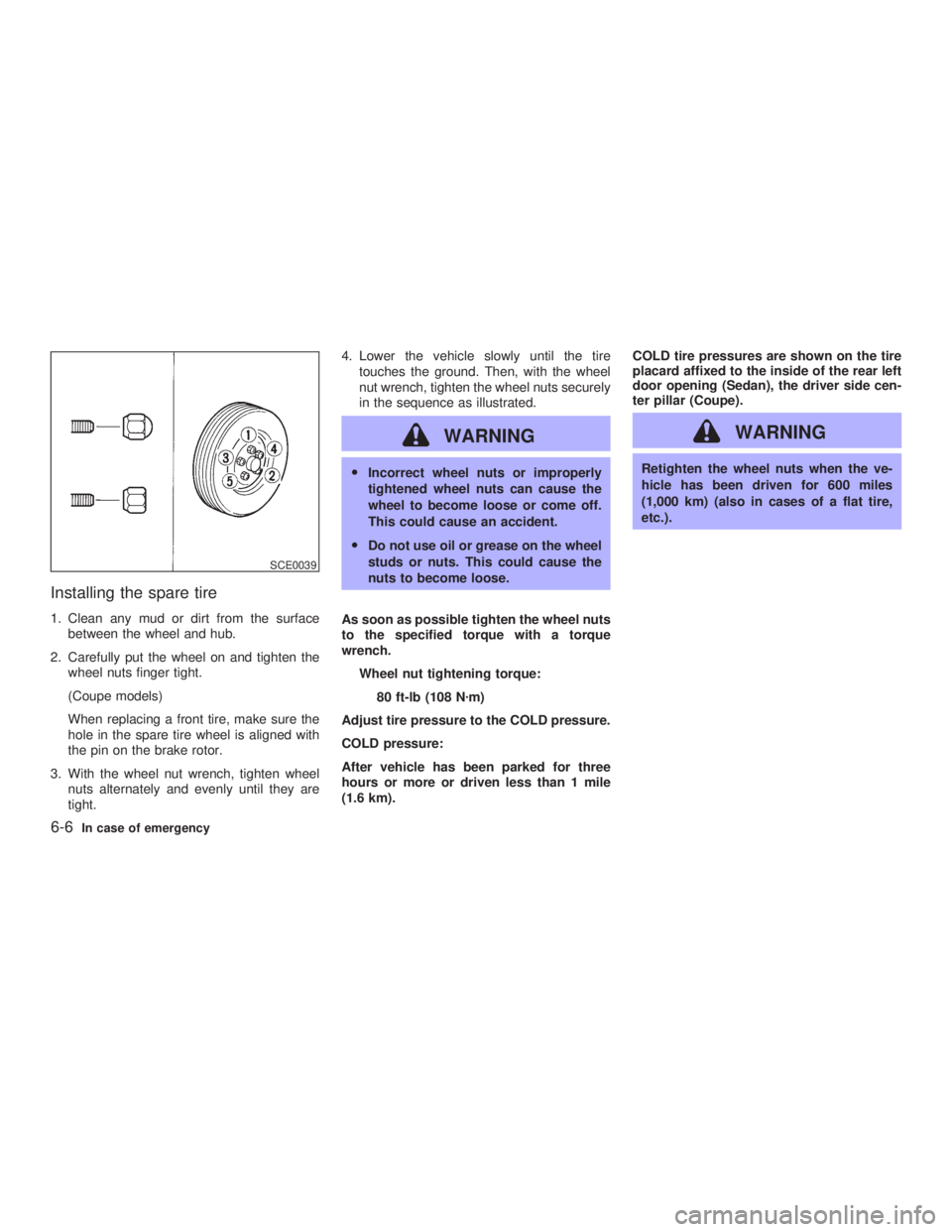
Installing the spare tire 1. Clean any mud or dirt from the surface
between the wheel and hub.
2. Carefully put the wheel on and tighten the
wheel nuts finger tight.
(Coupe models)
When replacing a front tire, make sure the
hole in the spare tire wheel is aligned with
the pin on the brake rotor.
3. With the wheel nut wrench, tighten wheel
nuts alternately and evenly until they are
tight. 4. Lower the vehicle slowly until the tire
touches the ground. Then, with the wheel
nut wrench, tighten the wheel nuts securely
in the sequence as illustrated.
WARNING O Incorrect wheel nuts or improperly
tightened wheel nuts can cause the
wheel to become loose or come off.
This could cause an accident.
O Do not use oil or grease on the wheel
studs or nuts. This could cause the
nuts to become loose.
As soon as possible tighten the wheel nuts
to the specified torque with a torque
wrench.
Wheel nut tightening torque:
80 ft-lb (108 N z m)
Adjust tire pressure to the COLD pressure.
COLD pressure:
After vehicle has been parked for three
hours or more or driven less than 1 mile
(1.6 km). COLD tire pressures are shown on the tire
placard affixed to the inside of the rear left
door opening (Sedan), the driver side cen-
ter pillar (Coupe).
WARNING Retighten the wheel nuts when the ve-
hicle has been driven for 600 miles
(1,000 km) (also in cases of a flat tire,
etc.).SCE0039
6-6 In case of emergency
Z 02.11.6/V35-D/V5.0
X
Page 179 of 256

8 Do-it-yourself Maintenance precautions .......................................... 8-2
Engine compartment check locations ....................... 8-4
Engine cooling system .............................................. 8-5
Checking engine coolant level ............................. 8-5
Changing engine coolant ..................................... 8-6
Engine oil .................................................................. 8-7
Checking engine oil level ..................................... 8-7
Changing engine oil and filter .............................. 8-8
Automatic transmission fluid ................................... 8-10
Power steering fluid ................................................ 8-10
Brake and clutch fluid ............................................. 8-11
Brake fluid .......................................................... 8-11
Clutch fluid.......................................................... 8-11
Window washer fluid ............................................... 8-12
Battery ..................................................................... 8-13
Jump starting ...................................................... 8-14
Drive belts ............................................................... 8-14
Spark plugs ............................................................. 8-15
Replacing spark plugs ........................................ 8-15
Air cleaner ............................................................... 8-16
Windshield wiper blades ......................................... 8-16
Cleaning ............................................................. 8-16
Replacing............................................................ 8-17 Parking brake and brake pedal ............................... 8-18
Checking parking brake ..................................... 8-18
Checking brake pedal ........................................ 8-18
Brake booster ..................................................... 8-19
Fuses....................................................................... 8-20
Engine compartment .......................................... 8-20
Passenger compartment .................................... 8-21
Keyfob battery replacement .................................... 8-21
Lights ....................................................................... 8-23
Headlights........................................................... 8-25
Exterior and interior lights .................................. 8-26
Wheels and tires ..................................................... 8-30
Tire pressure ...................................................... 8-30
Types of tires...................................................... 8-30
Tire chains .......................................................... 8-31
Changing wheels and tires ................................. 8-32
Z 02.7.29/V35-D/V5.0
X
Page 208 of 256
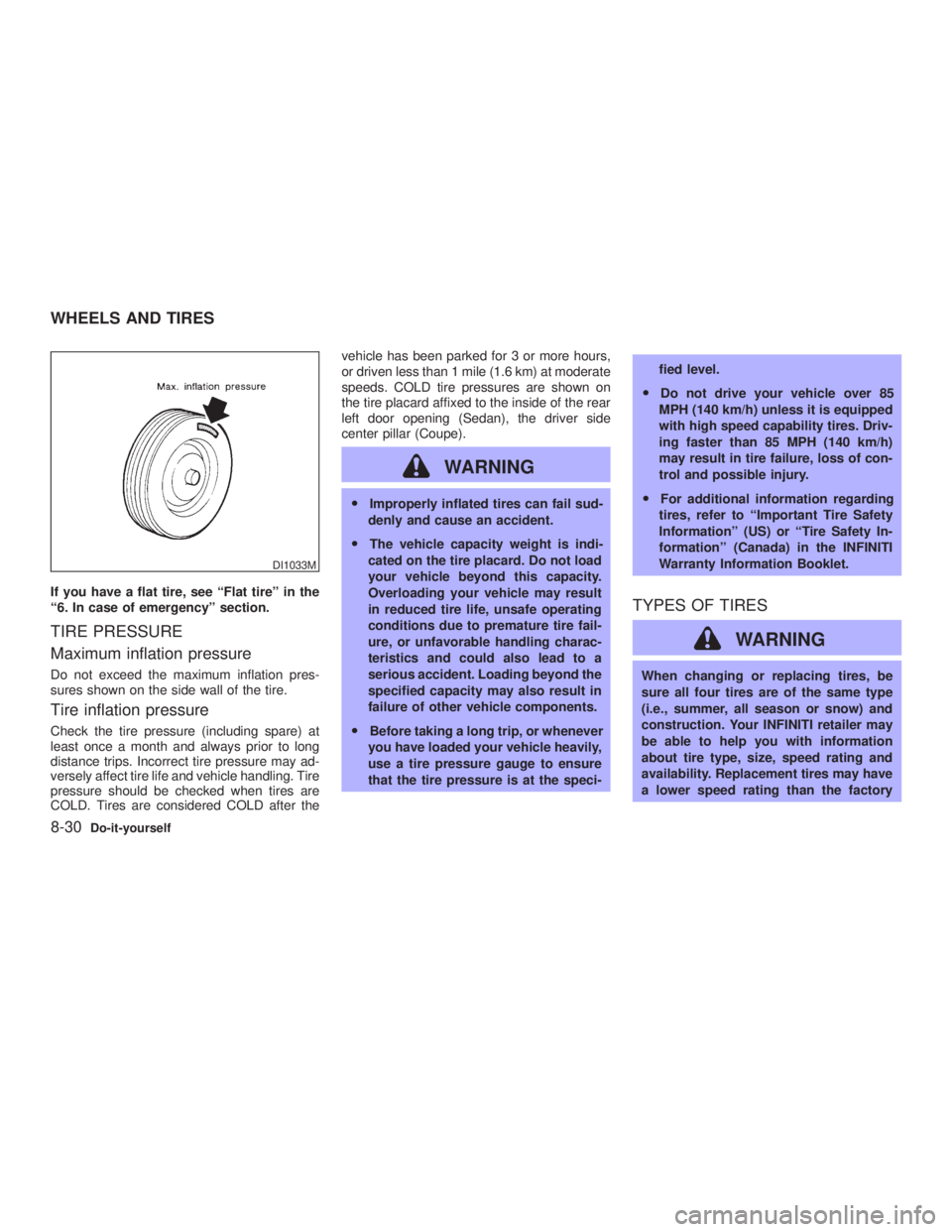
If you have a flat tire, see ªFlat tireº in the
ª6. In case of emergencyº section.
TIRE PRESSURE
Maximum inflation pressure Do not exceed the maximum inflation pres-
sures shown on the side wall of the tire.
Tire inflation pressure Check the tire pressure (including spare) at
least once a month and always prior to long
distance trips. Incorrect tire pressure may ad-
versely affect tire life and vehicle handling. Tire
pressure should be checked when tires are
COLD. Tires are considered COLD after the vehicle has been parked for 3 or more hours,
or driven less than 1 mile (1.6 km) at moderate
speeds. COLD tire pressures are shown on
the tire placard affixed to the inside of the rear
left door opening (Sedan), the driver side
center pillar (Coupe).
WARNING O Improperly inflated tires can fail sud-
denly and cause an accident.
O The vehicle capacity weight is indi-
cated on the tire placard. Do not load
your vehicle beyond this capacity.
Overloading your vehicle may result
in reduced tire life, unsafe operating
conditions due to premature tire fail-
ure, or unfavorable handling charac-
teristics and could also lead to a
serious accident. Loading beyond the
specified capacity may also result in
failure of other vehicle components.
O Before taking a long trip, or whenever
you have loaded your vehicle heavily,
use a tire pressure gauge to ensure
that the tire pressure is at the speci- fied level.
O Do not drive your vehicle over 85
MPH (140 km/h) unless it is equipped
with high speed capability tires. Driv-
ing faster than 85 MPH (140 km/h)
may result in tire failure, loss of con-
trol and possible injury.
O For additional information regarding
tires, refer to ªImportant Tire Safety
Informationº (US) or ªTire Safety In-
formationº (Canada) in the INFINITI
Warranty Information Booklet.
TYPES OF TIRES
WARNING When changing or replacing tires, be
sure all four tires are of the same type
(i.e., summer, all season or snow) and
construction. Your INFINITI retailer may
be able to help you with information
about tire type, size, speed rating and
availability. Replacement tires may have
a lower speed rating than the factoryDI1033M
WHEELS AND TIRES
8-30 Do-it-yourself
Z 02.7.29/V35-D/V5.0
X
Page 210 of 256
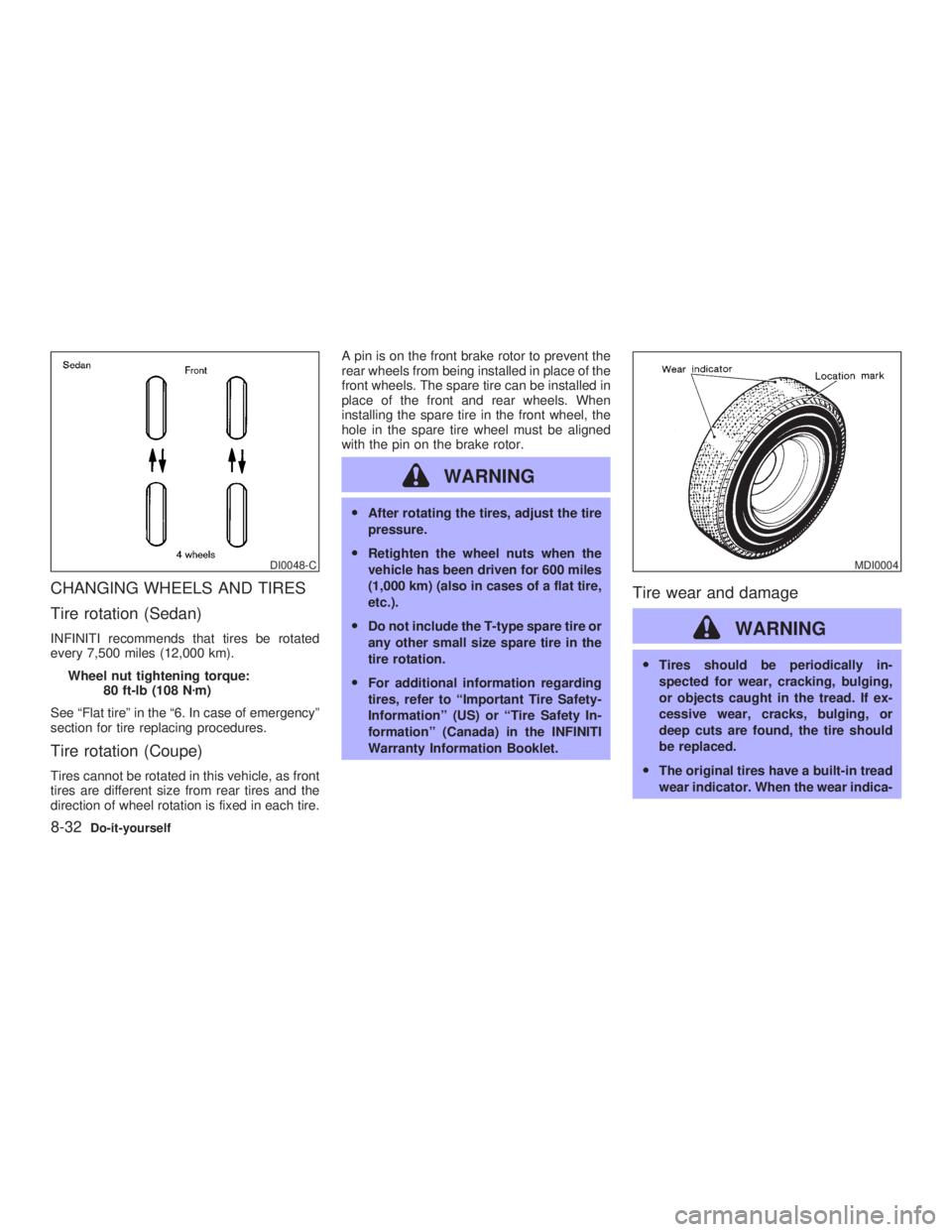
CHANGING WHEELS AND TIRES
Tire rotation (Sedan) INFINITI recommends that tires be rotated
every 7,500 miles (12,000 km).
Wheel nut tightening torque:
80 ft-lb (108 N z m)
See ªFlat tireº in the ª6. In case of emergencyº
section for tire replacing procedures.
Tire rotation (Coupe) Tires cannot be rotated in this vehicle, as front
tires are different size from rear tires and the
direction of wheel rotation is fixed in each tire. A pin is on the front brake rotor to prevent the
rear wheels from being installed in place of the
front wheels. The spare tire can be installed in
place of the front and rear wheels. When
installing the spare tire in the front wheel, the
hole in the spare tire wheel must be aligned
with the pin on the brake rotor.
WARNING O After rotating the tires, adjust the tire
pressure.
O Retighten the wheel nuts when the
vehicle has been driven for 600 miles
(1,000 km) (also in cases of a flat tire,
etc.).
O Do not include the T-type spare tire or
any other small size spare tire in the
tire rotation.
O For additional information regarding
tires, refer to ªImportant Tire Safety-
Informationº (US) or ªTire Safety In-
formationº (Canada) in the INFINITI
Warranty Information Booklet. Tire wear and damage
WARNING O Tires should be periodically in-
spected for wear, cracking, bulging,
or objects caught in the tread. If ex-
cessive wear, cracks, bulging, or
deep cuts are found, the tire should
be replaced.
O The original tires have a built-in tread
wear indicator. When the wear indica-DI0048-C MDI0004
8-32 Do-it-yourself
Z 02.11.1/V35-D/V5.0
X
Page 212 of 256
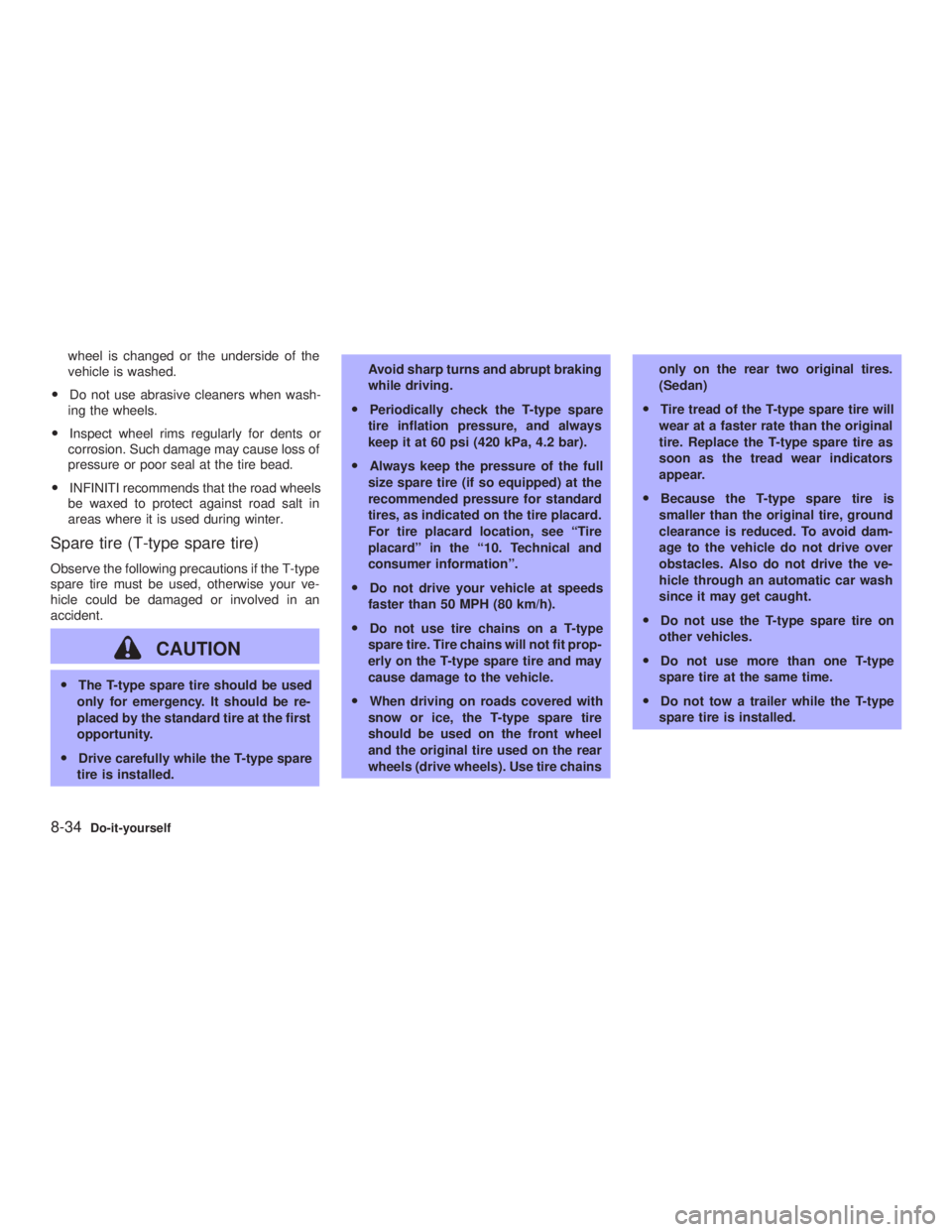
wheel is changed or the underside of the
vehicle is washed.
O Do not use abrasive cleaners when wash-
ing the wheels.
O Inspect wheel rims regularly for dents or
corrosion. Such damage may cause loss of
pressure or poor seal at the tire bead.
O INFINITI recommends that the road wheels
be waxed to protect against road salt in
areas where it is used during winter.
Spare tire (T-type spare tire) Observe the following precautions if the T-type
spare tire must be used, otherwise your ve-
hicle could be damaged or involved in an
accident.
CAUTIONO The T-type spare tire should be used
only for emergency. It should be re-
placed by the standard tire at the first
opportunity.
O Drive carefully while the T-type spare
tire is installed. Avoid sharp turns and abrupt braking
while driving.
O Periodically check the T-type spare
tire inflation pressure, and always
keep it at 60 psi (420 kPa, 4.2 bar).
O Always keep the pressure of the full
size spare tire (if so equipped) at the
recommended pressure for standard
tires, as indicated on the tire placard.
For tire placard location, see ªTire
placardº in the ª10. Technical and
consumer informationº.
O Do not drive your vehicle at speeds
faster than 50 MPH (80 km/h).
O Do not use tire chains on a T-type
spare tire. Tire chains will not fit prop-
erly on the T-type spare tire and may
cause damage to the vehicle.
O When driving on roads covered with
snow or ice, the T-type spare tire
should be used on the front wheel
and the original tire used on the rear
wheels (drive wheels). Use tire chains only on the rear two original tires.
(Sedan)
O Tire tread of the T-type spare tire will
wear at a faster rate than the original
tire. Replace the T-type spare tire as
soon as the tread wear indicators
appear.
O Because the T-type spare tire is
smaller than the original tire, ground
clearance is reduced. To avoid dam-
age to the vehicle do not drive over
obstacles. Also do not drive the ve-
hicle through an automatic car wash
since it may get caught.
O Do not use the T-type spare tire on
other vehicles.
O Do not use more than one T-type
spare tire at the same time.
O Do not tow a trailer while the T-type
spare tire is installed.
8-34 Do-it-yourself
Z 02.7.29/V35-D/V5.0
X
Page 215 of 256

EXPLANATION OF MAINTENANCE
ITEMS Additional information on the following
items with ª*º is found in the ª8. Do-it-
yourselfº section.
Outside the vehicle The maintenance items listed here should be
performed from time to time, unless otherwise
specified.
Tires*: Check the pressure with a gauge at
least once a month and always prior to long
distance trips. If necessary, adjust the pres-
sure in all tires, including the spare, to the
specified pressure. Check carefully for dam-
age, cuts or excessive wear.
Wheel nuts*: When checking the tires, make
sure no nuts are missing, and check for any
loose nuts. Tighten if necessary.
Tire rotation*: Tires should be rotated every
7,500 miles (12,000 km) (Sedan).
Tires cannot be rotated (Coupe).
Wheel alignment and balance: If the vehicle
pulls to either side while driving on a straight
and level road, or if you detect uneven or
abnormal tire wear, there may be a need for
wheel alignment. If the steering wheel or seat vibrates at normal
highway speeds, wheel balancing may be
needed.
For additional information regarding tires, refer
to ªImportant Tire Safety Informationº (US) or
ªTire Safety Informationº (Canada) in the
INFINITI Warranty Information booklet.
Windshield: Clean the windshield on a regu-
lar basis. Check the windshield at least every
six months for cracks or other damage. Have a
damaged windshield repaired by a qualified
repair facility.
Windshield wiper blades*: Check for cracks
or wear if they do not wipe properly.
Doors and engine hood: Check that all doors
and the engine hood, operate properly. Also
ensure that all latches lock securely. Lubricate
hinges and latches if necessary. Make sure
that the secondary latch keeps the hood from
opening when the primary latch is released.
When driving in areas using road salt or other
corrosive materials, check lubrication fre-
quently.
Inside the vehicle The maintenance items listed here should be
checked on a regular basis, such as when performing periodic maintenance, cleaning the
vehicle, etc.
Lights*: Clean the headlights on a regular
basis. Make sure that the headlights, stop
lights, tail lights, turn signal lights, and other
lights are all operating properly and installed
securely. Also check headlight aim.
Warning lights and chimes: Make sure that
all warning lights and chimes are operating
properly.
Windshield wiper and washer*: Check that
the wipers and washer operate properly and
that the wipers do not streak.
Windshield defroster: Check that the air
comes out of the defroster outlets properly and
in sufficient quantity when operating the heater
or air conditioner.
Steering wheel: Check for changes in the
steering conditions, such as excessive free
play, hard steering or strange noises.
Seats: Check seat position controls such as
seat adjusters, seatback recliner, etc. to en-
sure they operate smoothly and that all latches
lock securely in every position. Check that the
head restraints move up and down smoothly
and that the locks (if so equipped) hold se-
curely in all latched positions. Maintenance
9-3
Z 02.7.29/V35-D/V5.0
X
Page 233 of 256
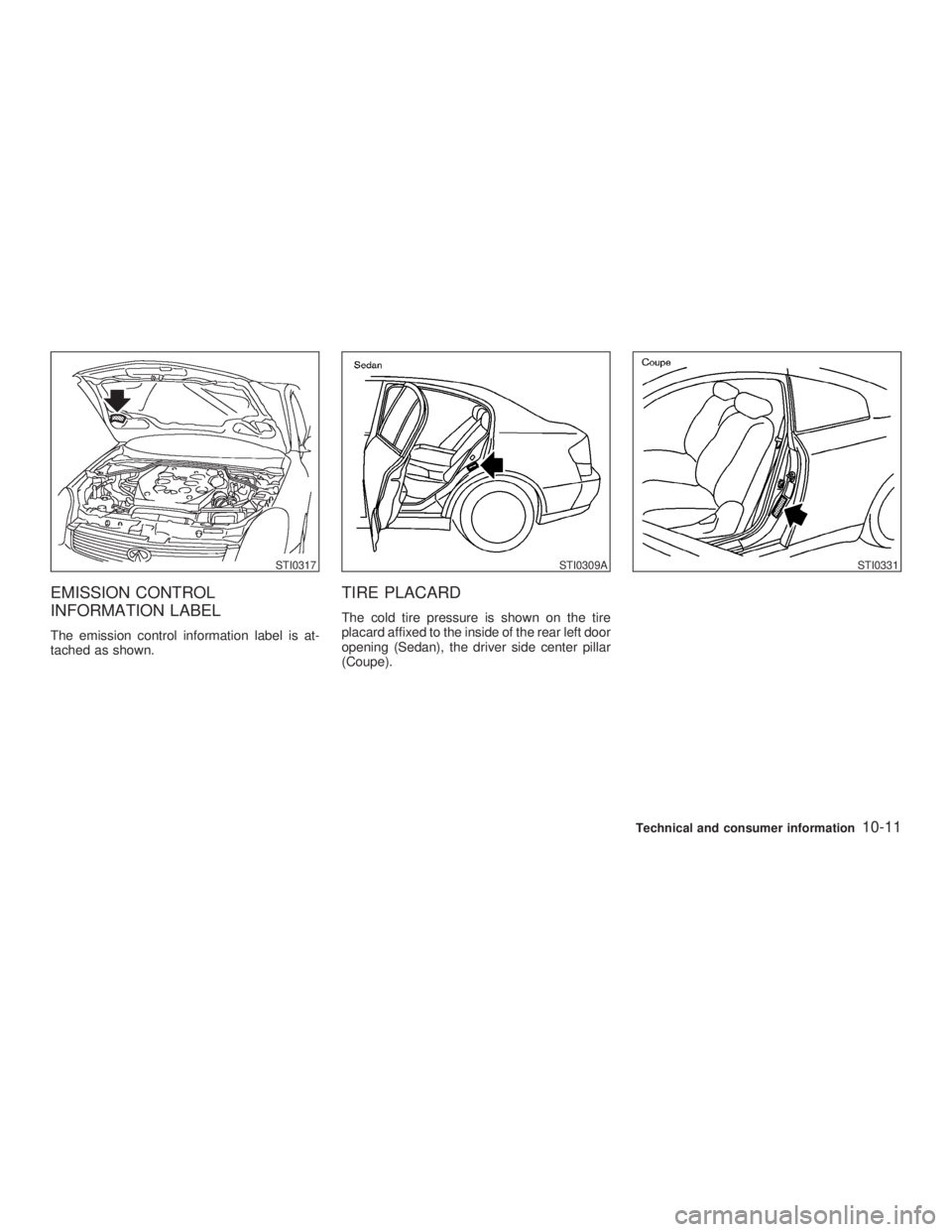
EMISSION CONTROL
INFORMATION LABEL The emission control information label is at-
tached as shown.
TIRE PLACARD The cold tire pressure is shown on the tire
placard affixed to the inside of the rear left door
opening (Sedan), the driver side center pillar
(Coupe).STI0317 STI0309A STI0331
Technical and consumer information
10-11
Z 02.7.29/V35-D/V5.0
X